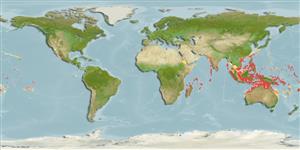>
Kurtiformes (Nurseryfishes, cardinalfishes.) >
Apogonidae (Cardinalfishes) > Pseudamiinae
Etymology: Pseudamia: Greek, pseudes = false + Greek, amia = a kind of shark (Ref. 45335).
More on authors: Randall, Lachner & Fraser.
Environment: milieu / climate zone / depth range / distribution range
Ecología
marino asociado a arrecife; rango de profundidad 2 - 64 m (Ref. 11890). Tropical; 32°N - 28°S
Indo-Pacific: Gulf of Aden to Samoa, north to southern Japan, south to Western Australia.
Tamaño / Peso / Age
Maturity: Lm ? range ? - ? cm
Max length : 10.0 cm TL macho / no sexado; (Ref. 48635)
Espinas dorsales (total): 7; Radios blandos dorsales (total): 8; Espinas anales 2; Radios blandos anales: 7 - 8; Vértebra: 24. Translucent when fresh with a reddish cast, overlaid with iridescence particularly on abdomen and operculum predominated by golden hues; dusky caudal fin with hyaline border; 1st and 2nd dorsal and anal fin pale to dusky or blackish, other fins are clear with pink rays. Anterior nostril without long flap. Rhomboid caudal fin. 23-24 scales in longitudinal series. Gill rakers 4-5+11-13, 1-7 developed. Convex interorbital space. Oblique mouth. Predorsal scales 10 (9-11). This species resembles P. amblyuroptera and P. gelatinosa but has larger scales (LR<=24) (Ref. 37816).
Inhabits lagoon and seaward reefs; hides in small caves and under ledges. Solitary and usually seen at night (Ref 90102).
Life cycle and mating behavior
Madurez | Reproducción | Puesta | Huevos | Fecundidad | Larva
Distinct pairing during courtship and spawning (Ref. 205).
Randall, J.E., E.A. Lachner and T.H. Fraser, 1985. Revision of the Indo-Pacific apogonid fish genus Pseudamia, with descriptions of three new species. Indo-Pac. Fish. 6:1-23. (Ref. 526)
IUCN Red List Status (Ref. 130435)
Threat to humans
Harmless
Human uses
Más información
ReferenciasAcuiculturaPerfil de acuiculturaRazasGenéticaElectrophoresesheritabilidadEnfermedadesProcesamientoNutrientsMass conversion
ColaboradoresImágenesStamps, Coins Misc.SonidosCiguateraVelocidadTipo de nataciónSuperficie branquialOtolitosCerebrosVisión
Herramientas
Special reports
Download XML
Fuentes de Internet
Estimates based on models
Preferred temperature (Ref.
123201): 26.2 - 29, mean 27.9 °C (based on 664 cells).
Phylogenetic diversity index (Ref.
82804): PD
50 = 0.5078 [Uniqueness, from 0.5 = low to 2.0 = high].
Bayesian length-weight: a=0.00389 (0.00180 - 0.00842), b=3.12 (2.94 - 3.30), in cm total length, based on all LWR estimates for this body shape (Ref.
93245).
Nivel trófico (Ref.
69278): 3.5 ±0.50 se; based on food items.
Resiliencia (Ref.
120179): Alto, población duplicada en un tiempo mínimo inferior a 15 meses (Preliminary K or Fecundity.).
Fishing Vulnerability (Ref.
59153): Low vulnerability (10 of 100).
Nutrients (Ref.
124155): Calcium = 162 [85, 278] mg/100g; Iron = 0.974 [0.560, 1.649] mg/100g; Protein = 18.5 [17.3, 19.6] %; Omega3 = 0.113 [0.063, 0.210] g/100g; Selenium = 39.2 [18.0, 85.9] μg/100g; VitaminA = 81.7 [26.0, 249.9] μg/100g; Zinc = 2.04 [1.32, 3.00] mg/100g (wet weight);
